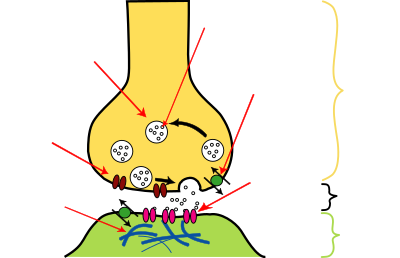Synaptic cleft
| Construction of a chemical synapse |
|---|
Synaptic gap is the neuroanatomical term for the narrow space between the presynaptic membrane region ( presynapse ) of a nerve cell and the postsynaptic (or subsynaptic) membrane region ( postsynapse ) of a downstream cell. For the transmission of excitation at will chemical synapses of the here usually about 20-30 nm wide synaptic cleft by discharging and docking of messengers ( neurotransmitters bridged).
function
For example, if an action potential reaches the end of the axon of a neuron , the signal has to be transmitted in some way to the target cell, be it a nerve cell, muscle cell or gland cell . This transmission takes place at the synapses . In the case of electrical synapses, there are direct connections between the two cells via so-called gap junctions , so that charge differences are promptly passed on as electrical signals and excitation can spread quickly in this connection.
In most synapses, however, the plasma membranes of the pre- and postsynaptic regions of the connected cells are not in direct contact, but are separated from one another by the synaptic gap. Although the intercellular space is only a 20 nm narrow gap at this point, the distance is already too far for electrical signals to jump over. In contrast to electrical synapses, the electrical signal at the presynaptic terminal is converted into a chemical signal for the transmission of excitation, namely into the amount of a certain messenger substance, called a neurotransmitter . In chemical synapses, the transmitted signal depends on the one hand on the type and quantity of the presynaptically released messenger molecules. These are packed in synaptic vesicles on the inside of the presynaptic membrane and ready for use and are released into the synaptic gap through exocytosis in response to the electrical signal (action potential) .
On the other hand, the postsynaptic equipment with specific membrane receptors for this neurotransmitter determines how the chemical signal is converted back into an electrical one. The presynaptically released molecules diffuse through the gap and bind to the corresponding neurotransmitter receptors on the postsynaptic membrane of the target cell. In the membrane of this cell, this leads directly (ligand-controlled ionotropic ) or indirectly ( metabotropic ) to the opening of ion channels and thus to changes in the membrane potential . These can either be designed in such a way that an action potential of this downstream cell is triggered under certain circumstances ( excitatory synapse) - or in such a way that an action potential formation is temporarily hindered ( inhibitory synapse). The binding of a neurotransmitter to its receptor is usually reversible, that is, it is released again and can be removed from the cleft by enzymatic degradation or by re-absorption in the presynaptic terminal.
Because of the transmission of excitation by means of messenger substances through the synaptic gap, the transmission of signals in chemical synapses is significantly slower (synaptic latency) than in electrical ones. But it allows different modulations and various modifications in the signal conversion - for example signals that lead to an inhibiting effect.
literature
- Bruce Alberts, among others: Textbook of Molecular Cell Biology . 2nd Edition. Wiley-VCH, Weinheim 2001, ISBN 3-527-30493-2 , pp. 426-428 .
- Neil A. Campbell, Jane B. Reece et al .: Biology . 8th, updated edition. Pearson Studium, 2009, ISBN 978-3-8273-7287-1 , pp. 1422-1424 .
Web links
Individual evidence
- ↑ Donald Voet, Judith G. Voet: Biochemistry, 4th Edition. John Wiley & Sons, 2010, ISBN 978-1-118-13993-6 . P. 440.
